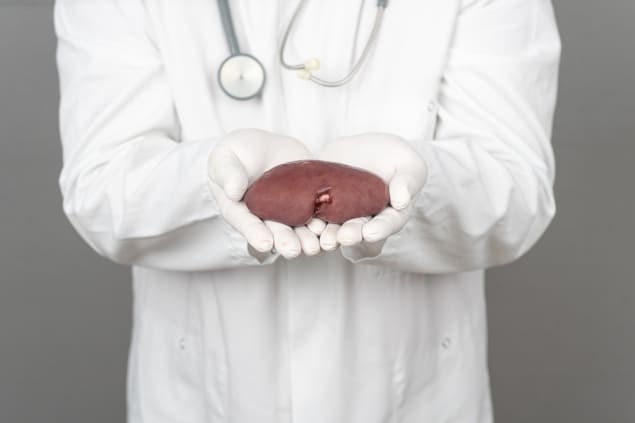
The waiting list for a kidney transplant grows each year and as a result, kidneys from higher risk donors are often included in the potential donor pool. Whilst the use of kidneys from these expanded criteria donors (ECD) has increased the number of transplants, transplant centres still discard a large proportion of ECD kidneys: nearly 45%, compared with just over 10% for standard criteria donor (SCD) kidneys.
These discards represent a largely untapped source of potentially viable kidneys. Current measures for assessing the viability of donor kidneys are mainly based on biopsies. But the relevance of rejecting a kidney based on biopsy results is contested. A US research team has now proposed that using optical coherence tomography (OCT) to image the tissue morphology of procured kidneys could provide additional information to supplement biopsy data in assessing viability and predicting post-transplant function (Biomed. Opt. Express 10.1364/BOE.10.001794).
OCT is an interferometry-based imaging modality that uses the light scattering characteristics of tissue to construct high-resolution images containing subsurface features. According to senior author Yu Chen, from the University of Maryland, OCT offers the ideal balance between resolution and penetration depth for assessing transplant kidneys.
“OCT possesses the resolution to discriminate fine kidney structures that are routinely assessed in traditional biopsies, and the penetration depth to image past the renal capsule and into the kidney cortex,” Chen explains.
Assessing viability
Chen and colleagues from Georgetown University Medical Center and Massachusetts Institute of Technology examined 169 kidneys: 66 from living donors and 103 from deceased donors. Of the deceased-donor kidneys, 88 were preserved using static cold storage and 15 using hypothermic machine perfusion, which is generally considered to be the superior storage method. In the static cold storage group, 26 kidneys were subcategorized as ECD and 62 as SCD; the hypothermic machine perfusion group included two ECD and 13 SCD kidneys.
The researchers used a 1325 nm spectral-domain OCT system to image all kidneys immediately before transplantation, and in vivo after reperfusion. Images were analysed automatically using MATLAB software. Analysis included segmenting the interface between the renal capsule and the kidney cortex, followed by segmentation of the kidney cortex and the lumen of proximal convoluted tubules (PCTs).
Potential donor kidneys are routinely evaluated for fibrosis, which may compromise graft viability. Fibrosis can cause flattening of PCT epithelial cells, leading to dilation of the lumen. Graft viability can also be compromised by acute tubular injury, which can induce dilation of the lumen or may manifest as swelling of the PCT epithelium due to ischemic damage. OCT can detect such swelling or dilation, and could provide a valuable tool for assessing kidney viability.
As such, the researchers assessed four measures of PCT morphology in each transplant group: lumen diameter; density (lumen area divided by the total area of quantifiable cortex); inter-lumen distance (which should increase as the epithelium swells); and inter-centroid distance (which may reflect changes in the interstitial space).
They then assessed the correlation between these parameters and patient outcome. Patients were categorized as having immediate graft function (IGF) if they did not require dialysis following transplant, or delayed graft function (DGF) if dialysis was required in the week after transplant.
Outcome prediction
The researchers ran two regression models for each transplant group: one using pre-implantation data to identify measurements that may predict post-transplant function and affect allocation or discard; and the other including all pre-implantation and post-reperfusion data, to find measurements that could influence post-operative care.
In the ECD subgroup, the model indicated that increased lumen diameter was the most predictive of developing DGF after transplant. When also including the post-reperfusion measurements, larger lumen diameter and higher density were most predictive of DGF.
In the SCD kidneys stored by SCS, there were no strong differences in measurements between IGF and DGF recovery groups. In SCD kidneys preserved by hypothermic machine perfusion, larger pre-implantation diameter was most predictive of DGF. When including all measurements, smaller post-reperfusion inter-lumen distance and lower post-reperfusion density were most predictive of DGF.
The results suggest that OCT measurements may be useful for predicting post-transplant function in ECD kidneys and kidneys stored by hypothermic machine perfusion. For OCT to be used effectively in a clinical setting, image analysis must be fast and reliable. The authors note that the fully automated system presented in this study could identify and segment the kidney microanatomy in OCT images with accuracy comparable to manual segmentation.
“This new kidney analysis technique will likely be of greatest use in assessing ECD kidneys,” says Chen. “These higher risk kidneys undergo the greatest amount of scrutiny, are routinely biopsied, and are most subject to discard. OCT could be employed to guide traditional biopsies, aid in interpretation of biopsies, and provide new information about the viability of the kidney.”
The researchers are now investigating the correlation between OCT images and the histology of biopsies captured at the imaging sites. Their aim is to show that OCT can non-invasively provide accurate measurements of kidney anatomy that mimic measurements of the biopsied tissue.
“Additionally, we are employing deep learning to develop a comprehensive classification model which will utilize OCT imaging data, together with patient and transplant data, to predict DGF,” Chen tells Physics World.



